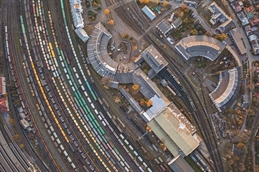
Europe needs to play a stronger leadership role in developing rail links with China in order to ensure the emerging connections achieve their true potential, a senior industry official told the European Silk Road Summit in Amsterdam.
“The idea of a New Silk Road has to be rebuilt and Europeans have to take the lead, thanks to the fact that there’s more than 50 years in this kind of market,” David Aloia, the Cantù, Italy-based head of Shuttle Net North-East Europe, and vice president, Landbridge China, for Swiss rail company Hupac, told the summit.
The gist of Aloia’s argument is how the Silk Road is spread. Europe has better-developed networks than China, which while strong on trunk lines, point-to-point operations and going straight to the big cities, has a less-radial vision of rail connections, one complicated by poor domestic links. All this, he says, is limiting the effectiveness of what is being built.
This, plus the competition as new-but-too-similar services have been introduced, have helped make the Silk Road an early victim of its own success, he says.
“We have lost a lot of synergies, especially in the European market,” he said.
Europe, he pointed out, has the skills and background to build the network, allowing for a better network, which it should now do to give a new impetus to the Silk Road, the name given to the increasing land connections, often rail, between China, the rest of Asia and Europe.
“The future is not so bright,” said Aloia. “Coordination between Europe and China is not as strong as should be. And that’s a very big mistake.”
There is lots to be resolved, especially on the software side.
One of Aloia’s slides listed issues which limit the New Silk Road – and are issues that were around when the first train was dispatched a decade ago. Of these, seven – restricted goods, capacity shortages, price stability and validity, China Rail connections and frequencies (and their constant changes), balance of flows and sustainability, overlap with other methods of transport, and subsidies – are still unresolved.
Only two, documentation and first- and last-mile – have been anywhere near dealt with, Aloia said. Whoever talks, and whenever they talk, he said, it’s going to be a fairly hefty agenda.
Two immediate problems need to be addressed, he said: scheduling and rotation of wagons and empty movements. Part of the latter is the oversupply of trains and rolling stock, he acknowledged, but the disruptions it can cause are on quite a scale.
“China is sending trains without sometimes informing, without a proper schedule, without a proper timetable,” he said, evidencing this with a quick summary of the problems arising at various borders.
Solutions are to be had, but none are immediate. One is for another track to, and then through, Turkey. While this idea gets industry support, he said, there is a counter view (See Southern Route sidebar.) The solution is a series of negotiations – probably lots of them, he said.
The other great problem he identified is the bugbear of so many, no matter who they are, what they move or where they are moving it: “the rotation of wagons and empty movements.” This is a well-known problem in the industry: there are lots of containers in Europe, with nothing going back to China.
Aloia was clear that this is something which cannot be ignored or sidestepped, but rather “has to be fixed very, very, soon.”
By Michael Mackey
Correspondent | Bangkok



